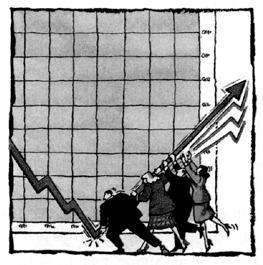Toward a New Business Model
The classical business model is a 19th-century invention. Has it outlived its usefulness? What should replace it? New research suggests alternatives that can lead to flexibility and growth for the bottom and top lines.
(originally published by Booz & Company)What makes our world so fascinating sometimes is that it travels at different speeds. Nations, peoples, individuals; all are at different points along their respective roads from the past. Global corporations are no different, according to authors Bruce Pasternak and Albert Viscio. A few have created new organizational forms - horizontal or team-based structures, for example; some have made progress in this direction, as they gradually adapt to new technologies; but the vast majority of companies are still structured more or less along 19th century lines: “a tightly-bound command-and-control hierarchy with a headquarters staff calling the shots from the top.
Messrs. Pasternak and Viscio, both of whom are management consultants with Booz-Allen & Hamilton in San Francisco, have studied hundreds of companies worldwide and, drawing on this experience as well as extensive academic research, argue strongly that this old business model is making it hard for global corporations to compete. Today’s world is simply too complex, and accelerating too quickly. The authors draw attention to the large proportion companies who have dropped off the Fortune 500 list since 1970.
The pace of world business as we approach the 21st Century calls for a new form of corporation, they say, one that focuses on knowledge and people - the ultimate creators of value. Citing the information highway, globalizing markets, stricter regulations, competitive pressures and technological innovation, Pasternak and Viscio urge companies to reinvent their business models if they are to flourish. Interdependence, rather than independence, will characterize this new business model and permit firms to deploy their capabilities widely and rapidly as they compete in the global market.
Some of the most basic and fundamental questions facing global business leaders are these: Is the current business model, which arose in the mills of Britain more than a century ago and has evolved ever since, still sufficient for these times? Is the model, which was described so well by the historian Alfred Chandler and management theorist Peter Drucker, capable of successfully handling the complexity and technology of today's global era? And is it still up to the task of delivering solid growth to the bottom line or even the top line?
Certainly the model, a tightly bound command-and-control hierarchy with a headquarters staff calling the shots from the top, has not remained static since it was first employed. Technology has enabled it to become flatter, larger and more far-flung. In its infancy, the model was capable of structuring and organizing only one line of business. With today's augmentations, the model works with higher levels of complexity, with multi-line businesses competing in a variety of sectors and along a number of dimensions--such as speed, quality and service. But the fact remains that the vast majority of companies, no matter how much their processes have been redesigned, are still structured largely along 19th-century lines.
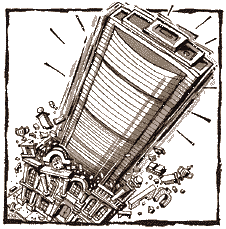
Illustration by Bill Morrison
As part of the research program at Booz-Allen & Hamilton, we have studied hundreds of companies worldwide and how they are structured, function and perform. This multilevel research endeavor is based both on case studies of individual companies and on empirical research. It draws not only from our work with dozens of clients worldwide, but also from academic research and from our own links to an international network of universities and scholars.
As a result of this work, we believe that the current business model has outlived it usefulness for large, global corporations. In fact, in some instances, the model is actually hindering a company's ability to compete.
As previously discussed in this journal in an article by Charles E. Lucier and Amy Asin ("Toward a New Theory of Growth," Issue 2), it is getting harder for companies to deliver profitable growth on a sustained basis. It is also more difficult for many companies to hold their ground and not fall behind. The key reasons include the dramatic increase in complexity in managing business and the increasing premium put on innovation. The complexity is due to significant and irreversible changes in the business environment. The pace of business is accelerating beyond the ability of most corporations to adjust. And value-adding opportunities must be found more frequently than previously.
There is a need, our work suggests, to build a new business model around the full array of capabilities a corporation can bring to bear in an efficient manner. Attempts have been made by companies in such countries as Argentina, Australia, Brazil, the United States and Switzerland, as well as in parts of Asia. But so far, no company has done it all. While the paradigm is shifting, it has yet to reach another stable state.
TECTONIC MOVEMENTS
It should be evident to anyone in business that companies today operate in an environment of enormous and continuous change. Changes on a massive scale, which once occurred rarely, are now everyday parts of the landscape. And it is unlikely that we will ever return to simpler times.
Just take one example: the number of autonomous countries in the world--with their myriad of self-regulated markets and market structures--has increased sharply in the past decade. These new countries and markets--many of which were closed for decades--are not only opening up, they are also producing tough new competition for existing companies almost overnight. In addition, they are serving as beachheads for the renewed assaults by older "mature" companies. These companies are moving their operations globally in an effort to become fiercer rivals. And these new countries and markets are all competing for capital. The corporation is in the middle of many of these changes and will--at a minimum--have to continually adjust to survive. [See Exhibit I.]
THE BUSINESS ENVIRONMENT
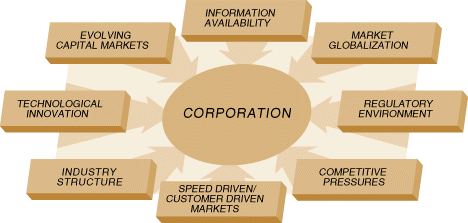
There are a number of major forces driving this age of change:
- Information is becoming readily available around the world at a record pace. The information highway gives customers and competitors instant access to each other. In the United States, the number of subscribers to on-line services grew 85 percent in 1995.
- Markets are globalizing, as are the companies that compete in them. In 1993, 43 percent of the sales of the world's 50 biggest companies came from outside the headquarters country.
For those companies that have not yet become "global" or are significantly increasing their position, the incremental complexity of managing a more extended operation can be dramatic, especially in terms of the drain on management resources.
- The regulatory environment is becoming stricter, and penalties more harsh. For example, more stringent environmental codes have been reinforced in the United States by 1991 Federal sentencing guidelines, which provide for jail sentences and stiff fines for executives of companies that break environmental laws.
- Competitive pressure has been intensifying and it is becoming harder to achieve leadership and to stay on top. Consider these statistics: 149 companies on the Fortune 500 list in 1970 had dropped off by 1980; by 1990, that number had almost doubled. The dropout rate in the 1990's continues at this fast pace, so that today's list bears only a slight resemblance to the list of 25 years ago. The more rapid change in fortunes of companies had spillover effects in the executive suite, putting C.E.O.'s increasingly under the gun. From mid-1991 to the end of 1992, for instance, 13 chief executives of Fortune 500 companies were ousted by their boards.
- The pace of business is faster with ever-rising customer expectations. New products are entering the market at a record pace. Companies such as Rubbermaid aim to develop a new product every day. New product introductions in the food industry more than tripled from 1980 to 1994. Today, there are twice as many products on supermarket shelves than there were 10 years ago. Computer chip manufacturers estimate that a new chip becomes a commodity within three months after the computer using the chip hits the market. Successful companies must be able to work at this rapid pace.

- Industry structures continue to evolve. In some cases the definition of the industry is changing, as with telecommunications or media. Between 1989 and 1994, there were more than 1,500 mergers in the United States banking industry. These changes mean new dynamics and new success factors.
- Technological innovation creates new market opportunities; it also demands rapid adjustment. Technological change has delivered the Information Age and converted it to the Knowledge Age. The cost of processing information has dropped precipitously. During the past 25 years, the cost to process one instruction per second has fallen by half each year. Moore's Law suggests that microprocessing power doubles every 18 months. Technological change underlies the wide set of options facing businesses in terms of how, where and when to find and capture opportunities, such as on the Internet.
- Finally, capital markets have evolved significantly. Investors are more activist and are demanding better performance. In the United States, institutional investors currently own 60 percent of all equities, compared with only 8 percent in 1950. In 1990, more shareholder proposals were passed than in the entire history of shareholder proposals up to that point. Money is raised on a more global scale today, with companies tapping a host of new sources.
ADAPTATION OR REINVENTION?
These changes have enormous implications for what a company has to do to be successful. Profit opportunities have become more fleeting as more products have been introduced to the market. At the same time, products must now be increasingly differentiated from each other, not just in highly fragmented home markets but also when companies enter global markets and encounter national differences and preferences. Thus, a company must become increasingly adept--not to mention quick--in its ability to adjust to changing times. [See Exhibit II.] It must also become much more precise in targeting windows of opportunity, more creative in how it competes and more customized in what it delivers.
NEW CHARACTERISTICS FOR SUCCESS
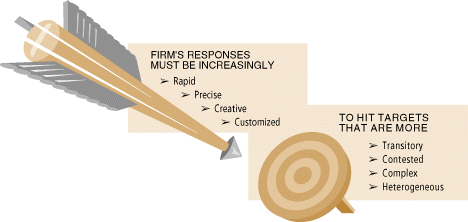
To thrive, management must insure that the corporation's most important assets--its knowledge and people--are world-class. By treating these assets as an essential element of top management's mission, companies guarantee a stronger "gene pool" for creating the products and services that the market wants. By doing so, they make themselves more viable and stronger. However, a "natural selection" process will make some pieces of the corporation more obsolete.
Knowledge is built from experience and is the primary building block of the company's capabilities. Though knowledge is often derived from information, it is more than data. It is strategic and focused on adding to the company's prowess by enabling the firm to do something significantly better than others. So real knowledge creates real value for shareholders. Managing knowledge involves, among other things, managing interactions and exchanges across organizational boundaries.
Though it may sound like a truism, it bears repeating that people are a firm's scarcest resource. This statement has been made repeatedly by C.E.O.'s and others in senior-level positions. People are the firm's repository of knowledge and central to the firm's competitive advantage. Well-trained, highly motivated people are crucial to the development and execution of strategies, especially in today's faster-paced, more complex world, where top management alone can no longer assure the firm's competitiveness.
In the future, firms will have to rely more on the work force to insure their competitive position. The complexity of identifying opportunities, creating new products and working across the organization requires more and better people. As a result, people are a significant investment in the future performance of the corporation. Motorola, for example, spends almost $100 million annually on education and training and calculates a return of $3 in sales for every education dollar spent. With the greater mobility of people, the specialization of skills and the high value those skills give to the corporation, companies need new human resource strategies to attract and develop the people required to make their businesses successful.
The new business model also mandates a different role for its leaders. Leaders must provide the company with an overall sense of purpose to give it direction and create a channel for the energies of the employees. They must also facilitate communication and cooperation across the corporation. Knowledge and people processes involve most of the corporation and cross organizational lines; leaders must facilitate these interactions. Thus, the emerging leadership model focuses on managing the total corporate resources, not just its assets. [See Exhibit III.]
THE NEW LEADERSHIP MODEL
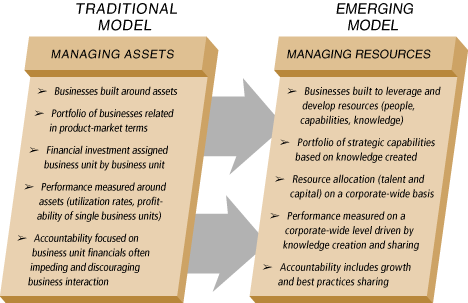
The firm must be able to build and deploy its capabilities rapidly without regard to organizational constraints. This new model has greater expectations about performance and value-added contributions from each element of the corporation.
THE NEW BUSINESS MODEL
Our studies indicate that corporations must reinvent their business models if they are to flourish in the more complex environment of the future. The new business model must enable the firm to generate growth opportunities, respond flexibly and capture the opportunities quickly and profitably. The model must be effective in managing knowledge and people processes. It will be characterized by the interdependence, rather than independence, of its parts, while insuring that each part of the firm is a contributor to value. This requires new roles for each of the firm's parts so that they can work together in new ways to help the company's resource base grow.
A firm's business model comprises five elements. [See Exhibit IV.] Although there is nothing novel in defining the corporation by its basic elements, there are significant differences from the traditional business model in the definition of the elements individually as well as collectively. On the latter point, the model must generate a "system" value in addition to the value from the individual parts. This system value is precisely the raison d'être of the corporation. It establishes what should be inside and what should be outside the corporation. It establishes the logic for building or acquiring new businesses. And it helps set the standards for performance expectations from each of the elements.
THE NEW BUSINESS MODEL
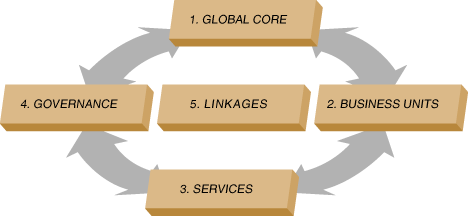
At the heart of the model is the global core, which is a radical transformation of the old corporate center. It is global in the sense that it is responsible for key missions across the corporation. It is a core because it is meant to add value to all of the other elements of the model, and not simply add overhead. It is not a center because execution of its mission is distributed across the corporation. The global nature of business makes it imperative that companies perform many core activities close to where they are needed. Technology enables this. The core's role is to add value where the businesses cannot, with the "burden of proof" on the core. An enhanced core is a necessary condition for profitable growth in an increasingly competitive and global business environment.
The global core has five key missions that meet the burden-of-proof test: identity, strategic leadership, capabilities, capital and control. Identity is based on a shared vision and value system. It adds value to the corporation across a wide set of constituents, including governments, public interest groups and customers. Strategic leadership provides the overall context for growth, helps develop the overall business portfolio, assists in fostering key alliances and creates the overall mandate for growth. Capabilities are the fundamental building blocks of competitive advantage. The core's role is to insure that the corporation has access to world-class capabilities and that they are allocated across the firm in the best possible way, a part of managing total firm resources.
The control mission is to define targets, monitor performance, meet legal and fiduciary requirements and comply with regulations. As part of this mission, the core must assume responsibility for compliance in key risk areas of the environment and safety. It must also manage the overall business risks across the company's operations. One major risk is falling short of shareholder expectations. The capital mission is to insure access to lowest-cost funding to support growth and to manage the financial risks of the corporation.
Business units must be worth more as part of the firm than they would outside of it, thus creating system value. This enhanced value may come from one or more sources. The business may benefit more from a number of sources, including the core. It may also benefit from interactions with other business units in such activities as best-practice exchanges, knowledge sharing and capabilities transfers.
To capture some of the potential value, business units will have to be managed differently. [See Exhibit V.] Greater interaction will have to become the standard. The boundaries separating business units must be permeable and flexible. Thus, the predominant measure for the corporation will be performance of the whole, not the sum of the parts. The challenge is that the clean accountability that has been established over the years now has some ambiguity. Unfortunately, that is the cost for the benefit of greater growth.
A NEW BUSINESS UNIT MODEL
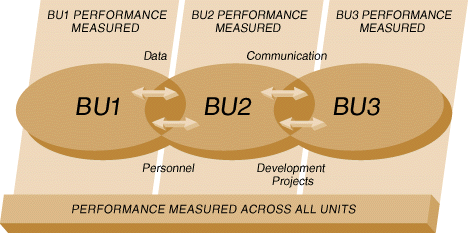
Service delivery can be from several sources, but central services out of the corporate center should not be one of them. Activities that exhibit economies of scale and are either too critical to outsource or for which the outsourcing market is not efficient can be put into a shared-service division. The principle of voluntary exchange is one of the key attributes distinguishing shared services from centralized functions. Another important dimension to shared-service delivery is to support subscale business activities in remote locations. Sharing can be among business units or initiated by corporate to provide the support needed for growth.
Governance is taking on a larger role in corporations. Four forces are driving this change. A push for performance is creating more active boards with greater C.E.O. accountability. Expansion of capital markets and the need to access new capital are especially important as family-owned businesses look to obtain financing or companies seek out capital in emerging markets such as China. Regulatory actions are forcing boards to become more pro-active to deal with everything from privatization issues to taxes on "excessive" C.E.O. compensation. And alliances, especially international and cross-cultural ones, are requiring adjustments in how ventures are governed.
Linkages tie the corporation together and cover issues such as organization, management processes and communications. Some linkages are corporate-wide, while others cover only certain elements of the business. [See Exhibit VI.] Linkages are needed between and among the five elements of the business model and within each. Many of the linkages are related to the firm's knowledge structure and people processes.
LINKAGES ARE IMPORTANT
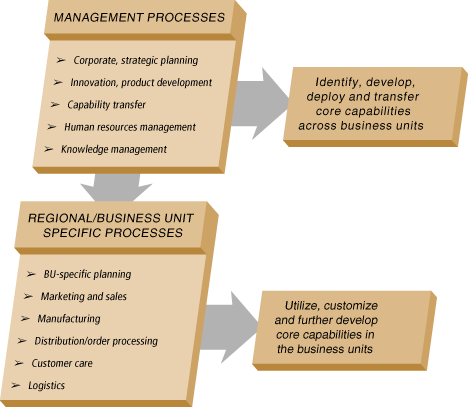
Some companies, such as 3M and Hewlett-Packard, have formed cross-business teams to create new product opportunities that combine technologies. Others, such as PepsiCo, use regular meetings of top managers to discuss new groundbreaking ideas. The range of linkage mechanisms is wide, but the overall objective is often to build beyond individual business lines.
In summary, to thrive amid the complexities of the new business environment, a new form of corporation is needed. That corporation must have a much stronger focus on the basics of what ultimately creates value--knowledge and people. It must create a leadership model that engages the full resources of the firm. And it must evolve toward a new business model that fosters the creation of value and insures that each piece of the business is a contributor to system-wide value. Without such changes, the primary direction for large corporations will be to get smaller to counter the complexity of size and diversity.
Our research suggests that the primary challenge for top management is to drive these changes and to lead their companies into the new business model. Success in this role will determine which companies wind up being the drivers of their industries. ![]()
Reprint No. 96201
| Authors
Albert J. Viscio, Albert J. Viscio is vice president of Booz-Allen. He is co-founder of the company's Organization and Strategic Leadership Practice, which is concerned with top management, organization, business model transformation and leadership issues. Mr. Viscio holds a B.A. in economics from Holy Cross College and a Ph.D. in economics from New York University. Mr. Pasternack and Dr. Viscio are authors of "The Centerless Corporation" (Simon & Schuster, 1998). Bruce A. Pasternack, pasternack_bruce@bah.com Bruce A. Pasternack is a senior vice president with Booz Allen Hamilton in San Francisco. He is the coauthor, with Albert J. Viscio, of The Centerless Corporation: A New Model for Transforming Your Organization for Growth and Profit (Simon & Shuster, 1998). |


